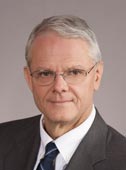Chair’s Column: Focus on Medical Student Education in Surgery

James Rutka
|
It is timely to inform all of you
of the upcoming accreditation
process of the Medical School
at the University of Toronto.
Medical schools in North
America undergo an accreditation
process every eight years.
This process is conducted by
a group of peers and medical
education experts who systematically
review every facet of the
MD program to determine whether the quality of education
meets common standards across North America.
In Canada, MD programs are accredited jointly by
the Committee on Accreditation of Canadian Medical
Schools (CACMS), and the Liaison Committee on
Medical Education (LCME). In preparation for accreditation,
we have submitted several documents which
provide the requisite information on how we teach
the surgical curriculum to our medical students at the
University of Toronto. The accreditation process itself
will take place May 13-16, 2012.
I think you would all agree that teaching medical
students about surgery is one of our most important
opportunities. During this past academic year, we have
paid particular attention to the wants and needs of
our medical students. One of my first tasks as Chair
was appointing a new Director and Coordinator of
Undergraduate Medical Education in the Department.
After extensive search processes, I was very pleased to
appoint George Christakis, Division of Cardiac Surgery,
Sunnybrook Health Sciences Centre as Director, and
Shibu Thomas as Coordinator. Together, George and
Shibu have worked extremely hard to improve the surgical
curriculum for the medical students, and to implement
innovative changes that will serve as a model for all
medical schools across North America. In particular, the
“crash course” for clinical clerks has been re-designed so
as to maximize learning of the core surgical materials in a concentrated and interactive format.
|
But we have done much more. Recently, Carol-Anne
Moulton, General Surgery UHN, and Ron Levine,
Director Post-graduate Medical Education, held a “Life
in Surgery” evening event at the Faculty Club for the
medical students in all years to learn about how to
achieve family and work balance in a career in surgery.
For this event, many of the participating faculty brought
their children to speak to the medical students about
what it was like growing up in the home of a surgeon.
In February, we held a “Suturing Workshop” for medical
students in which years 1 and 2 students purchased
suture kits, subsidized in part by the Department
of Surgery, and learned
the art and practice of
tying surgical knots, and
closing surgical wounds
on a simulation model.
Special thanks are given
to medical students,
Nada Gawad and Konrad
Salata, for their help in
organizing this workshop,
and to the many
faculty who participated
in making it so successful.
John Wedge, former
Chair of the Department of Surgery, helped tremendously
with the workshop, and had this to say: “… I
thought this a vitally important opportunity to demonstrate
our interest in students in their formative years - to
put a positive light on surgery as a career option. The
current ethos from most medical educators does not
typically paint surgery as an attractive career so it is critical
that we do whatever possible to counteract this trend.
Kudos to the Department in initiating this program! The
determination and ability to learn quickly of all of the
students with whom I interacted was very impressive and
encouraging for me.”
Most of the Divisions have been attending the Student
Surgical Skills Development (S3D) Group evenings in
which representatives of the Divisions attend the dinner
or lunch events, and speak to the medical students about
a career as a surgical subspecialist. I would like to thank
Sarah Beech, medical student at UofT, who has helped
us organize these seminars. Sarah has also been involved in
providing exposure to medical students wishing to
practice basic surgical skills on model systems.
This summer we will be assisting with the Surgery
Exploration and Discovery (SEAD) course which will
provide medical students with an opportunity to learn
more about the careers of the different subspecialties
in surgery. Special thanks are once again given to Nada
Gawad who has organized this course for the students
with our support.
Finally, I have begun a “Breakfast with the Chairman”
initiative in which I meet with the medical students at
the Banting Institute over breakfast to provide information
to them about career paths in surgery, and to answer
their many questions. It has been a distinct pleasure for
me to see the various new offerings we are supporting
in the Department of Surgery for our medical students.
Our strong hope is that we can encourage many more of
them to contemplate lives and careers in surgery upon
graduation. To this end, over the next 5 years, we will be
tracking the courses of our graduating medical students
to see if we have made a difference in this regard.
James T Rutka,
RS McLaughlin Professor and Chair
|